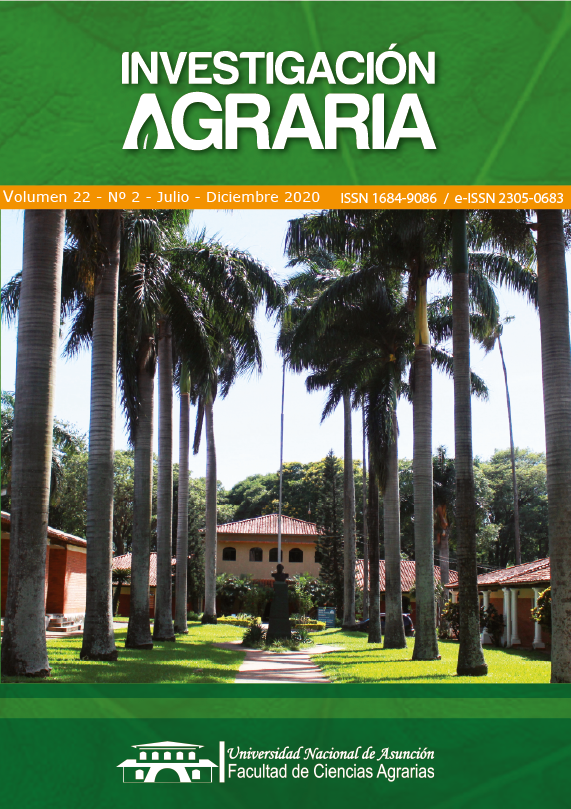Eficácia do ozônio em Sitophilus oryzae (L.) (Coleoptera: Curculionidae) em condições de laboratório
DOI:
https://doi.org/10.18004/investig.agrar.2020.diciembre.2202640%20Palavras-chave:
Sitophilus oryzae, control, inseticida, siloResumo
O ozônio tem sido utilizado como estratégia de controle de fungos e insetos que afetam grãos e alimentos armazenados, devido a sua alta reatividade e forte atividade oxidante. Nesta pesquisa avaliou-se o efeito inseticida do ozônio na concentração de 20 ppm em adultos do gorgulho do arroz, Sitophilus oryzae (L.), aplicado durante 15, 30, 45 e 60 minutos, em protótipos de silos vazios e silos com milho. O delineamento do experimento foi inteiramente casualizado com matriz fatorial. Houve diferenças significativas (P <0,001) na porcentagem de mortalidade dos silos vazios do gorgulho do arroz (53,5%) e aqueles com milho (16,88%). O tempo de exposição também causou efeito significativo na mortalidade (P <0,001), que aumentou com o tempo e atingiu o maior valor aos 60 minutos (58,25%). Da mesma forma, a interação condição silo pelo tempo de exposição ao ozônio foi significativa (P <0,001) e permitiu observar diferenças na mortalidade de S. oryzae, cujas porcentagens foram maiores em silos vazios do que em silos com milho. Esses resultados mostram que o ozônio teve um efeito inseticida moderado sobre S. oryzae.Downloads
Métricas
Referências
Alonso, M., Ávila, J. y Calcagno, M. (2009). Los cereales en el trópico suramericano: Técnicas modernas de conservación. CDCHT ULA, Fundación Empresas Polar. Caracas, Venezuela.
Campabadal, C.A., Maier, D.E. & Mason, L.J. (2013). Efficacy of fixed bed ozonation treatment to control insects in stored bulk grain. Applied Engineering in Agriculture, 29(5), 693-704.
Dos Santos, J.E., Martins, M.A., Faroni, L.R., Pereira de Andrade, M. & Silva, M.C. (2007).Ozonitation process: Saturation time, decomposition kinetics and quality of maize grains (Zea mays L.). En: IOA (International Ozone Association) Conference and Exhibition. Valencia, España.
Faroni, L.R., Pereira, A.M., Sousa, A.H., Coelho da Silva, M.T. & Irrazabal, W. (2007). Influence of corn grain mass temperature on ozone toxicity to Sitophilus zeamais (Coleoptera: Curculionidae) and quality of oil extracted from ozonized grains. IOA Conference and Exhibition Valencia, Spain. October (29-31). 5.8: 1-6.
Hansen, L.S., Hansen, P. & Jensen, K.M.V. (2012). Lethal doses of ozone for control of all stages of internal and external feeders in stored products. Pest Management Science, 68, 1311-1316.
Hardin, J.A., Jones, C.L., Bonjour, E.L., Noyes, R.T., Beeby, R.L., Eltiste, D.A. & Decker, S. (2010). Ozone fumigation of stored grain: closed-loop recirculation and the rate of ozone consumption. Journal of Stored Products Research, 46, 149-154.
Hasan, M., Phillips, T.W. & Aikins, M.J. (2012). Potential for ozone fumigation against anobiid beetles infesting stored products as an alternative to methyl bromide. En Navarro, S., Banks, H.J., Jayas, D.S., Bell, C.H., Noyes, R.T., Ferizli, A.G., Emekci, M., Işikber, A.A. & Alagusundaram, K. (Eds.) Proc. 9th. Int. Conf. on Controlled Atmosphere and Fumigation in Stored Products, Antalya, Turkey. 15 - 19. October 2012, ARBER Professional Congress Service, Turkey 260 - 265.
Işikber, A.A. & Öztekin, S. (2009). Comparison of susceptibility of two stored-product insects, Ephestia kuehniella Zeller and Tribolium confusum du Val to gaseous ozone. Journal of Stored Products Research, 45, 159-164.
Işikber, A.A. & Athanassiou, C.G. (2015). The use of ozone gas for the control of insects and micro-organisms in stored products. Journal of Stored Products Research, 64, 139-145.
Jian, F., Jayas, D.S. & White, N.D.G. (2013). Can ozone be a new control strategy for pests of stored grain. Agricultural Research, 2(1), 1-8.
Keivanloo, E., Namaghi, H.S. & Haddad, M.H. (2014). Effects of low ozone concentrations and short exposure times on the mortality of immature stages of the Indian meal moth, Plodia interpunctella (Lepidoptera: Pyralidae). Journal of Plant Protection Research, 54(3), 267-271.
Kells, S.A., Mason, L.J., Maier, D.E. & Woloshuk, C.P. (2001). Efficacy and fumigation characteristics of ozone in stored maize. Journal of Stored Products, 37(4), 371-382.
Mason, L.J., Woloshuk, C.P. & Maier, D.E. (1997). Efficacy of ozone to control insects, moulds and mycotoxins. En: Donahaye, E.J., Navarro, S., Varnava, A. (Eds.). Proceedings of the International Conference on Controlled Atmosphere and Fumigation in Stored Products. Nicosia. 665-670 pp.
Pandiselvam, R., Sunoj, S., Manikantan, M.R., Kothakota, A. & Hebbar, K.B. (2016). Application and kinetics of ozone in food preservation. Ozone: Science & Engineering. https://doi.org/10.1080/01919512.2016.1268947
Pereira, A.D.M., Faroni, L.R.D., Sousa, A.H., Urruchi, W.I. & Paes, J.L. (2008). Influence of the grain temperature on the ozone toxicity to Tribolium castaneum. Revista Brasileira de Engenharia Agrícola e Ambiental, 12, 493-497.
Reza, G., Asgar, A. & Hasan, M. (2011). Combined effect of ozone mixed with carbon dioxide on the mortality of five stored-product insects. Egyptian Academic Journal of Biological Sciences, 4(2), 9-19.
Rozado, A.F., Faroni, L.R.A., Urruchi, W.M.I., Guedes, R.N.C. & Paes, J.L. (2008). Aplicação de ozônio contra Sitophilus zeamais e Tribolium castaneum em milho armazenado. Revista Brasileira de Engenharia Agrícola e Ambiental, 12(3), 282-285.
Solano, Y., Triana, J., Ávila, R., Hernández, D. y Morales, J. (2017). Efecto del ozono sobre adultos del gorgojo del cigarrillo, Lasioderma serricorne (F.) (Coleoptera: Anobiidae). IDESIA (Chile), 35(2), 41-47 http://dx.doi.org/10.4067/S0718-34292017005000007
Sousa, A.H., Faroni, L.R.A., Pimentel, M.A.G., Silva, G.N. & Guedes, R.N.C. (2016). Ozone toxicity to Sitophilus zeamais (Coleoptera: Curculionidae) populations under selections pressure from ozone. Journal of Stored Products Research, 65, 1-5.
Sousa, A.H., Faroni, L.R.A. & Guedes, R.N.C. (2017). Locomotor behavior of Sitophilus zeamais populations under sublethal ozone exposure. Journal of Pest Science, 90, 239-247.
Trombete, F.M., Freitas-Silva, O., Saldanha, T., Venáncio, A.A. & Fraga, M.E. (2016). Ozone against mycotoxins and pesticide residues in food: Current applications and perspectives. International Food Research Journal, 23(6), 2545-2556.
Wysok, B., Uradzinski, J. & Gomólka-Pawlicka, M. (2006). Ozone as an alternative disinfectant - A review. Polish Journal of Food and Nutrition Sciences, 15/56(1), 3-8.
Publicado
Como Citar
Edição
Seção
Licença

Este trabalho está licenciado sob uma licença Creative Commons Attribution 4.0 International License.
Todo o conteúdo desta revista está sob Licença de Atribuição Creative Commons.









 Todo o conteúdo desta revista está abaixo
Todo o conteúdo desta revista está abaixo 